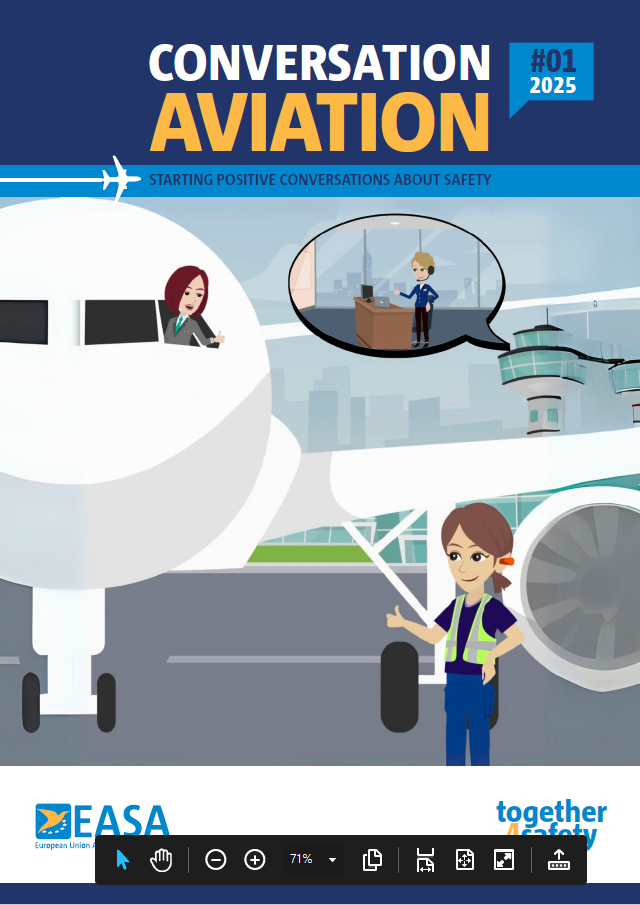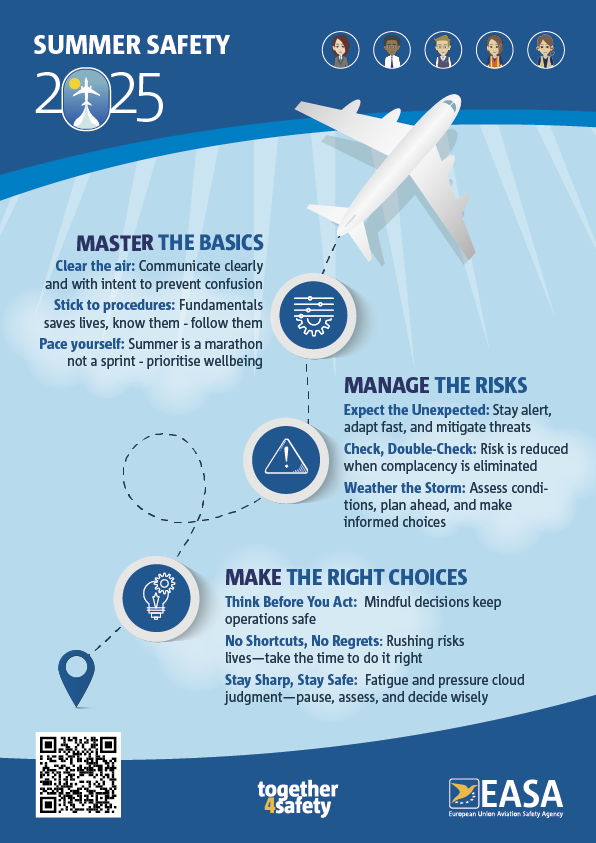As we stand at the beginning of the summer season, things really start ramping-up, and it’s 5 long months to the end of September. Some days it will feel like our staff are running a 100-metre sprint. It might seem strange to remind you, but no one can run a marathon in 100-metre sprints. If we are to get ourselves safely through the whole summer, we must pace ourselves.
Whatever type of organisation you work for it is vital that safe and effective operations are repeatable, every single day. We are likely to face all sorts of challenges.
Download the Summer 2025 Conversation Aviation Magazine
The summer 2025 edition of Conversation Aviation is now online and ready to download in single or double page spread. We have lots of exciting topics for you.
Download the magazine at the link here.

Find out more about the European Cockpit Association's Summer Campaign
The European Cockpit Association (ECA) are also running a summer campaign with lots of useful information.
Join our Summer Webinars and Events
We will be hosting a number of different webinars and events during May. Register by clicking on the different links below - all webinars run from 1215 to 1345 CET:
29 April - Summer Campaign Launch Webinar: Watch the video on Youtube here. Download the Presentations at the bottom of the page - the topics covered were:
Introduction to the Summer Campaign and EASA’s Top Safety Risks – John Franklin, EASA.
IATA’s View on the Safety This Summer – Matt Lilywhite, Safety Risk Manager, IATA.
Maintenance and CAMO Safety – Marco Manodori Sagredo, EASA.
Integrating Simulators and Real World Flying – Prokopis Batzanopoulos, EASA.
- Promoting Safety to Operational Staff – Callum Hutchinson, easyJet.
15 May - Cabin Safety Webinar (Live from Oslo): Register here now.
20-22 May - Business Aviation Safety (At EBACE in Geneva with the EBAA): Find out more on the EBACE Website here.
22-23 May - EASA IATA PNT Resilience Workshop (In-Person in Cologne:
29 May - Safety Culture (to be confirmed).
Aviate – Navigate – Communicate
When there is an emergency in an aircraft the first thing pilots are trained to do in an emergency is “Aviate-Navigate-Communicate”. At times of increased stress, it’s important to focus on the basics. Get those right, create more mental capacity and build as the situation comes under control.
This concept leads to the 3 key messages for the summer and within each there are additional points under each of these:

People Create Safety
When it comes to the safety of our respective day-to-day operations the most important thing to remember is that regardless of all the rules, procedures, safety systems and risk assessment, it’s people who create safety. We rely on the whole aviation system - flight and cabin crews, maintainers, ATC, ground handling et al - to ensure a safe summer. We ask our people to perform under difficult conditions in challenging situations under a lot of pressure, especially during the summer. Every organisation needs to ask the question: “do we have enough competent people who are operationally ready, fit for duty and who understand their responsibilities”.
As we approach the summer season, the statement from the “People” part of the EASA Safety Map is more important than ever.

The Importance of Collaboration
Before we start talking about the things that individuals can be prepared for this summer, it is first important to talk about the invaluable role of collaboration between organisations. Every safe flight involves interactions between people from many different domains and organisations. There are three key aspects of collaboration that we should be thinking about this summer:
Contractual/Service Interfaces. For organisations, it is vital to work with any contracted service providers so that any risks are identified clearly and mitigated effectively. It isn’t easy to communicate to staff in other people’s organisation, so this can take a lot of effort.
Airport/Aerodrome Specific Issues. There are also specific risks at individual airports/aerodromes, and it is vital that collaboration takes place between all the main stakeholders involved. Of particular importance is the Local Runway Safety Team.
Industry-wide Learning. Finally, the more we can share information at an industry level the better placed we are to learn from each others’ experiences. We will provide updates continually over the summer through our Conversation Aviation LinkedIn Group.
Pay Attention to the Interfaces
The different aviation staff routinely do their jobs quite happily in their own domains/silos but there are key moments in the preparation and performance of every flight where different staff members come together. We must focus on these interfaces, communicate clearly with each other and give each other our full attention. Some of these key moments are:
Discussion on technical issues between engineers and flight crew, particularly on go/no go decisions.
Liaison between flight crew and dispatchers to ensure paperwork is completed correctly and that ground staff leave the aircraft at the right time.
Removing steps from the aircraft [at the appropriate time] to ensure there is no risk of falls.
Ensuring that all personnel, equipment and vehicles are out of the way before the aircraft moves under power for the first time.
Any communication between ATC and the flight deck must use standard phraseology at all times. English native speakers should pay particular attention the recipient of your message may not be a native English speaker”.
Operationally Ready and Fit for Duty
The part about being operationally ready and fit for duty goes beyond just compliance with rules of Flight Time Limitations (FTL) for flight crew. It is important to do everything you can to manage the human risks that might prevent your staff performing to the best of their abilities. Encourage open conversations about people’s wellbeing. The role of leaders is not to work their staff like machines until they break with a focus only on the task.
Consider John Adair’s famous Action Centred Leadership model that highlights the balance between the needs of the task, the needs of the team and the needs of the individual. If we focus only on the task element, it will truly be a horrible summer. Ensure everyone from leaders to front-line workers are asking themselves “Where are my circles?”
Having Clear Responsibilities
We recently added to the safety model with a part to ensure that people understand their responsibilities clearly. If we do not have a clear understanding of who does what in the team and what people’s individual responsibilities are then things might get missed or fall between the gaps. This is where the circles come in again. We must ensure not only that individuals know their jobs, but also that everyone in the team knows who is doing what. As always, communication is vital.
Key Decision Points
As human beings, we spend a lot of our time on autopilot, doing familiar tasks that we always do; but in many situations this can often lead to incidents or accidents. By taking mindful decisions together with others we can minimise the risk of making a wrong decision.
Here are 10 key decision points that should be made mindfully to ensure safety during a flight:
Before Take-off
Pushback & Engine Start. Confirm clearance, ensure a safe pushback path and verify engine start parameters.
Taxiing from the Gate. Maintain situational awareness, adhere to taxi clearances and watch for ground movements traffic.
Entering the Runway. Conduct a final approach check, confirm clearance and scan for potential conflicting traffic.
Take-off Roll Decision. Be ready to reject take-off if any anomalies arise (engine issues, ATC cancellation, traffic conflict etc).
During Flight
Climb & Transition to Cruise. Monitor aircraft performance, adjust for weather conditions and communicate with ATC.
Navigating Weather & Airspace. Think and plan ahead and adjust routing proactively to avoid turbulence, storms and/or traffic congestion.
Descent Planning. Optimise energy management, factor in approach conditions and coordinate with ATC.
Approach & Landing
Approach Stability. Adhere to stabilised approach criteria; be ready to go around.
Landing & Rollout. Execute a safe touchdown, manage speed and be mindful of braking and runway exit.
After Landing
Taxiing to the Gate. Maintain vigilance for traffic, follow ATC instructions carefully and ensure safe parking.
Each of these moments requires situational awareness, communication and sound decision-making to ensure a safe flight.
Finally, Report, Report, Report and Talk about Safety Continually
Learning is such an important part of safety. Throughout the summer it is vital that everyone continually talks openly about safety. Make sure that staff feel suitably empowered to raise a concern if they consider that there is a problem”.
Most components part of aviation operations are conducted by small teams, often working in relative autonomy, so incident reporting to your organisation’s SMS should be actively encouraged; this is vital not only to sharing information with the wider team, but also to ensuring that new or evolving risks are captured, highlighted and managed openly and proactively.
We must all encourage our teams to consider the specific risks in our respective operations: there is no “cry wolf” when it comes to safety reporting. From reports received, potential trends can be identified and system-wide mitigations put in place - it could be an issue at a specific airport or with a specific piece of airspace where common challenges are starting to emerge.
There are 3 specific resources when it comes to mindset, culture and reporting in general - feel free to use any of these in your own promotion work.
EASA Safety Map: Specifically the importance of Mindset and Learning.
Occurrence Reporting for Learning: The view that occurrence reporting is more than just meeting a regulatory requirement.
The Lifecycle of an Occurrence Report: What happens to a safety report both in an organisation and once it goes to the National Authority/ EASA.
We also cover different aspects of reporting and the associated topics in various articles in the Conversation Aviation Magazine as follows:
Edition 1-2023 - Page 21: Airline CEOs view of reporting.
Edition 1-2024 - Pages 4, 7 and 11: Various articles on the Dirty Dozen, culture, mindset and the link to reporting.
Edition 3-2024 - Page 11: What happens to occurrence reports.
Keep an eye on the EASA Air Ops Community to read and learn about the evolving risks this summer being shared form other areas of the aviation operation.
Please log in or sign up to comment.